Apple variety Idared
Idared apples are a high-yielding red winter variety. It was bred in 1955 in the United States, based on the well-known varieties Jonathan and Wagner. After a couple of years, it was adapted in Europe. The variety came to Russia in the 60s, it was grown mainly in the Kuban. Now it is popular among gardeners in Ukraine, Belarus, Poland.
- Benefit and harm
- Contraindications
- Description and characteristics of the variety
- What a tree and fruits look like
- Flavoring features
- Winter hardiness
- Yield
- Disease and pest resistance
- Growing
- Landing
- Care
- General recommendations
- Pollinators for this apple tree
- Using the variety as a pollinator
- Maturation features
- The beginning of fruiting
- Ripening terms
- Storage and harvesting
- In which regions can you grow
- Reviews of gardeners
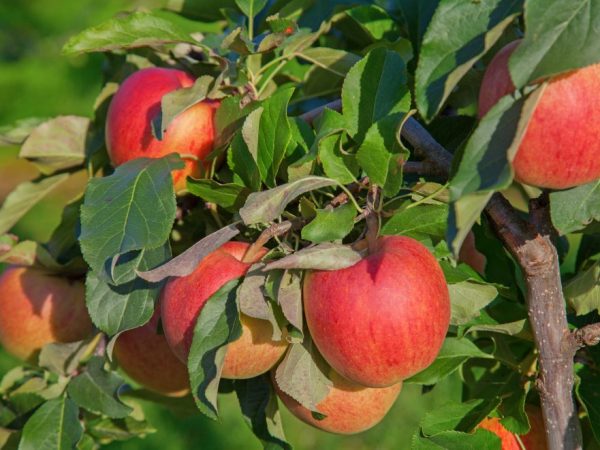
Apple variety Idared
Benefit and harm
Idared belongs to the red apple, which contains a lot of iron. It is often recommended for anemia. But the benefits are not limited to just that. They are stored for a long time, many vitamins and minerals are preserved in them until spring.
The peel and pulp are rich in carotene, ascorbic acid, nicotinamide. These substances have a positive effect on the condition of the skin and blood vessels, strengthen the immune system.
Particular attention should be paid to the group of B vitamins, which include thiamine, folic and pantothenic acid. They affect the nervous system, hematopoiesis, and prevent anemia. Apples contain a lot of potassium, which affects the normal functioning of the heart. They also contain calcium and phosphorus, which are essential for bones.
More than 80% of the fruit mass is water. They are good thirst quenchers and are low in calories. Fiber, which regulates the digestive tract, accounts for about 8-10%. The skin of Idared is coated with a thin coating of pectin, which is beneficial for joints and intestines.
Taking into account all the useful substances that the fruit contains, it is recommended for many diseases. It is useful for people with heart problems, hypertension, arthritis and arthrosis. Vitamin product is advised to eat pregnant and children, athletes. Since Idared apples are low in calories, they help you lose weight.
Contraindications
In rare cases, red-skinned apples cause allergies. If you eat too many of them, you can provoke uric acid diathesis or cystitis.
People with colitis, stomach ulcers and duodenal ulcers are advised with caution to eat the product. With such diagnoses, it is better to bake apples.
Description and characteristics of the variety
Before buying seedlings, be sure to get acquainted with the description of the variety, its advantages and disadvantages. A lot of planting material is now being imported to Russia from abroad. But the quality of domestic products is in no way inferior.
What a tree and fruits look like
The young annual seedling has gray-brown branches. The leaves are dark green with a bluish tint, strongly folded and slightly wrinkled. They are attached to the branches with thick petioles; there are widened stipules at the base.
The most intensive growth of the Idared apple tree is observed in the first 3-4 years of life. By the age of 10-12, development practically stops.
A description of a mature tree looks like this:
- Height from 3.5 to 6 m.
- The crown is semicircular or oval.
- The branches stretch strongly upward, spaced at an angle of 45⁰ to the trunk.
- The bark is dark brown, evenly colored.
- The barrel is thick and powerful.
- Shoots are brown, with a grayish tinge, straight, covered with liquid villi. Cranking is poorly expressed, lenticels are clearly visible, branches are rounded at the cut.
- The leaves are dark green, ovoid (less often oval or elongated).
- The hairiness on the leaves is clearly visible from the underside, from above they are shiny, glossy.
- Leaf edge with large waves, double-toothed.
- All leaves are located in the center of the crown, curl slightly clockwise.
- The petioles of the leaves are thin, located almost at right angles to the branch.
The crown of the Idared apple tree is prone to thickening, so in the first years it must be thinned out.
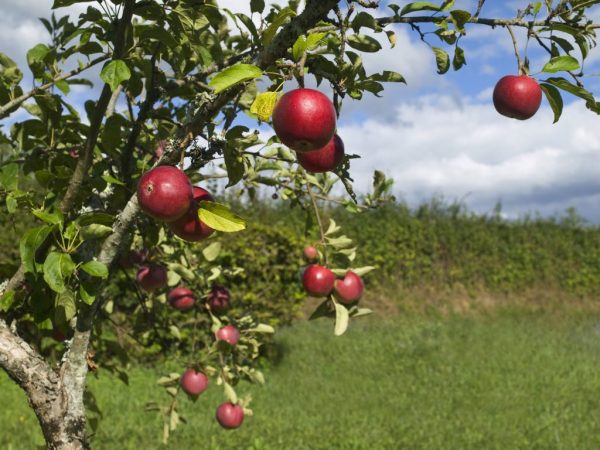
The crown of the tree must be thinned out
Description of flowers and fruits:
- Early flowering, beginning in late April.
- The flowers are large, white-pink in color, the pink color is more intense at the tips.
- The flowers resemble a saucer in shape.
- The inflorescence is a large scutellum.
- Pistils are short, without pubescence.
- The anthers of the stamens and the stigma of the pistil are located at the same level.
- Fruits are collected in rings of 2-3 pieces, in productive years they form garlands, evenly distributed along the branch.
- The average fruit weight is 135-145 g, the largest ones reach 200-225 g.
- The shape is round, for large apples it is conical.
- The color is yellow-green, with carmine sides and a crimson spot on the side facing the sun.
- Small light specks and strokes are visible under the skin, giving the apple a marble pattern.
- The rind is thin and elastic, covered with bloom.
- The saucer is narrow, with a small closed cup and a large cylindrical subassembly tube.
- The funnel is deep and narrowed.
- The peduncle is of medium length.
- The pulp is creamy.
Flavoring features
The taste of Idared apples is sweet with pronounced sourness. The smell is mild, it quickly disappears during storage.
The structure of fresh pulp is dense, but quickly becomes fibrous, then fine-grained and friable. At the same time, it remains juicy for a long time.
Winter hardiness
The Idared apple variety cannot be called winter-hardy, its indicators are average.
It was bred in the southern states of the United States, so little attention was paid to this characteristic. In severe frosts, young cuttings planted in the fall may die.
It is recommended to cover young trees for the winter in cold regions. Cold resistance decreases if the root collar is left during planting higher than 3-4 cm above the soil surface. Mature trees can die at temperatures as low as -20⁰С.
In addition to the tree itself, the ovaries react to late frosts. After all, the tree blooms early, at the end of April. In some regions, during this period, the temperature at night can easily drop below zero. In addition, the fruits ripen at the end of September, early frosts can destroy the crop.
Yield
Apple trees at the age of 6-7 years produce about 30 kg of products, at 10 years (at the peak of their yield) - up to 90 kg. In the southern regions, 300-400 centners of fruits are harvested per hectare, and in good years - up to 500 centners.
Fruiting in warm regions is regular. A bountiful harvest is taken from mature trees every year. This allows the cultivar to be grown on an industrial scale.
In the middle lane, flowers can fall prey to early frosts. Therefore, in the north, apple trees are more often planted for personal use, because yields are unstable there.
Disease and pest resistance
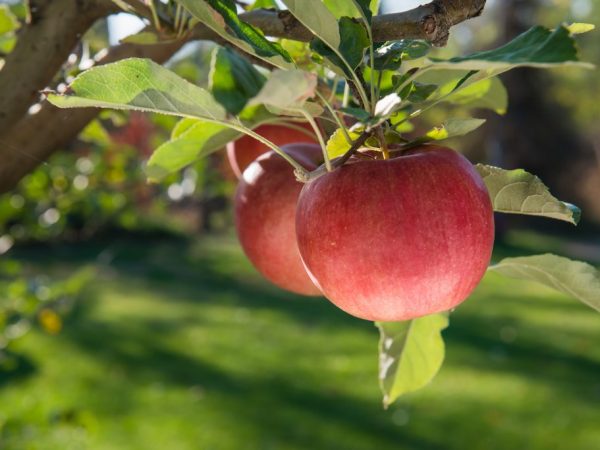
Idared variety resistant to diseases
The variety has good immunity. It is resistant to brown spotting. Rarely enough it is affected by scab and powdery mildew (medium level of resistance).
Pests are more likely to infect trees than diseases. The most common parasites are:
- Aphid. Green insects feeding on the sap of the leaves. They lay eggs in autumn and in early spring the larvae begin to destroy young leaves.
- Medianitsa. Damages young buds, flowers, tree roots.
- Red tick.Damages foliage.
- Apple sawfly. It feeds on small fruits or ovaries, which is why they fall off en masse.
- Fruit moth. Lives in ripe fruits, causing great harm to the crop.
To combat pests, trees are treated several times per season with Bordeaux liquid, tobacco infusion. It is possible to get rid of the copperhead only with the help of chemical insecticides.
Growing
To successfully grow Idared on your site, you need to buy high-quality seedlings. It is best to do this in proven nurseries.
Purposeful breeding is carried out in the Kuban, in the Stavropol Territory. Material is also brought to Russia from Poland, Ukraine, Belarus.
It used to be possible to find German seedlings, but now their number has decreased because demand has dropped.
Landing
You can plant trees in autumn or spring. The first option is considered more correct, the seedlings have time to adapt during the winter and grow intensively in the spring.
The pit begins to be prepared 1.5-2 months before planting (if it is carried out in the spring, then the pit is dug in the fall).
The preparation consists of the following steps:
- Digging land and removing weeds.
- Introducing a mixture of sand, peat and humus in equal parts into the dug soil (approximately a bucket per hole). This increases the moisture content of the soil, prevents root decay, and increases fertility.
- Digging a hole with a diameter of 100-120 cm and a depth of 60-80 cm.
Fertilizers can be applied directly to the pit. To do this, first, drainage from expanded clay, small pebbles or crushed brick is placed on the bottom. Then a bucket of sand is poured, the same amount of peat and humus and everything is thoroughly mixed.
The seedlings are lowered into the pit strictly vertically. The roots are carefully straightened so that they do not bend at the bottom. The hole is covered with soil so that the root collar is 3 cm above its surface. Then 2-3 buckets of water are poured under the tree.
Care
First year
In the first year, you do not need to take special care of the seedling. The main thing is to water it 5-6 times per season. Trees after spring planting need even more frequent watering, up to 7-8 times, especially in dry summers. One watering requires 2-3 buckets of water.
Second year
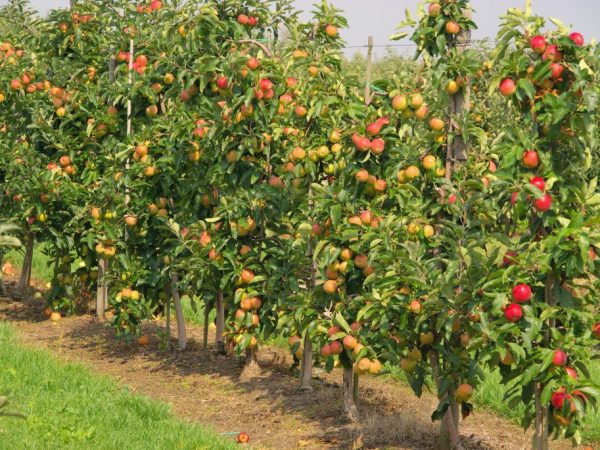
Trees need to be fertilized regularly
Fertilizers are started. Until the apple tree begins to bear fruit, it needs nitrogen fertilizers. The best option is 10-15 g of ammonium nitrate under a tree every spring.
Third year
From 3-4 years old, it is necessary to feed Idared with superphosphate and potash fertilizers, 1 tsp each. under a tree during flowering and the beginning of fruit ripening.
This increases the yield, prevents premature falling of apples.
Mature tree
Water it 5-6 times per season. But one needs 2-4 buckets of water. It is especially important to moisten the soil before flowering and during fruit setting.
In a rainy summer, watering is reduced, since the variety does not like excess moisture.
General recommendations
Since the crown is prone to thickening, it is imperative to prune it annually. This is done in late February or early March.
Remove damaged, crooked and dried branches. Shoots bear fruit best at the age of 2-4 years, the older ones should be removed. After this, the cut sites are covered with garden var.
Pollinators for this apple tree
All varieties of apples, including Idared, are bisexual. This means that there are male organs (stamens) and female organs (pistils) in the flower. Pollination requires insects to transfer pollen from the pistil to the stamen. There it germinates, forming a pollen tube through which sperm move. When they reach the bottom of the pistil, they fertilize the egg that is there. Subsequently, seeds develop from it, and from the pistil an ovary and a fruit.
In the process of evolution, apple trees have developed a protective mechanism against self-pollination. It is important for ensuring the genetic diversity of the offspring and the better survival of the species under changing environmental conditions. Pollen from flowers from one tree cannot fertilize an egg. The pistil does not emit substances that stimulate its germination.
Trees of the same variety are genetically homogeneous, as they are grown in a vegetative way. Therefore, they can pollinate each other only in rare cases.
Approximately 1.7-2.5% of the flowers turn into fruits. If pollination is carried out artificially, you can get a crop of 2.6-7% of flowers.
To get 12-25% of fruits, it is necessary to plant pollinators of other varieties in one garden. An important condition is that all apple trees bloom at the same time.
The best pollinators are:
- James Grieve
- Rubin
- Starking
- Starkrimson
- Gloucester
- Florina
- The mermaid
- Wagner
- Ruby Dooks
- Red Delicious
- Kuban spur
It is recommended to plant 1 pollinator per 12-20 trees of the main variety.
Using the variety as a pollinator
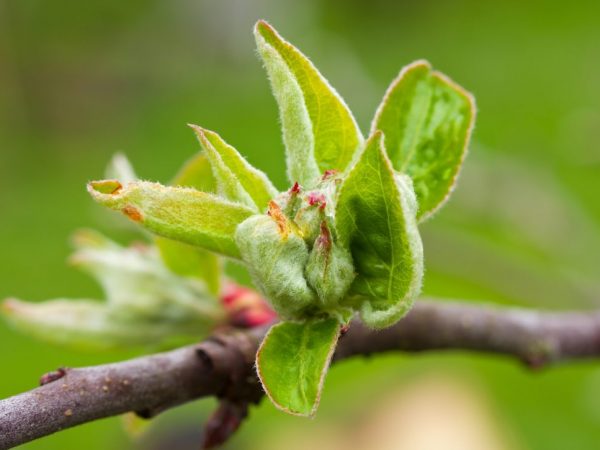
The variety has high pollen viability
The pollination quality is largely influenced by the viability of pollen. For Idared, it is 40-90%, these are very high rates. Therefore, he himself is used as a pollinator.
It is best suited for these varieties:
- Champion
- Empire
- Gala Delicious
- Golden Delicious
- Jonagold
- Renet Simerenko
- Berbourne
- Burbourne Mariri Red
- Elstar
- Fuji
- Gala mast
- Gala Brockfilt
- Banquet
- Gloucester
- Verge Challenger
- Delivar
- Facets Smith
- Ionic
- Mutsu
In Poland, in industrial cultivation, Idared is combined with 2-3 other varieties. They are planted in turn, 2-3 rows each.
It is important to note that apple trees do not change their qualities during the cross-pollination process. New traits appear in seed reared. That is why cultivated varieties reproduce exclusively vegetatively, and new ones are hatched at specialized stations by means of artificial pollination.
Maturation features
Idared belongs to the winter varieties of apple trees, which affects the time of its ripening.
The beginning of fruiting
The fruits ripen early enough. Dwarf varieties for 3 years can please with fruits. Large trees bear fruit a little later, by 4-5 years.
By this time, the seedling is strong enough and can provide the fruits with all the necessary substances.
If in the first year flowering is abundant, there are too many ovaries, it is recommended to partially or completely remove them. If this is not done, the apple tree may become depleted, slow down its growth, or dry out altogether. Sometimes young trees shed flowers or ovaries by themselves.
Ripening terms
Despite the earlier flowering, the fruits ripen at the end of September. From the appearance of the ovaries to the moment of full condition of the fruit, it takes 4-4.5 months.
At first, the peel has a deep green color, then it turns yellow-green, red carmine shades appear. On the south side of the tree, the apples are crimson.
After ripening, they stick well and firmly on the branches, they may not fall until the frosts themselves. But it's better to rip them off in time. The best taste appears 120-140 days after harvest.
Storage and harvesting
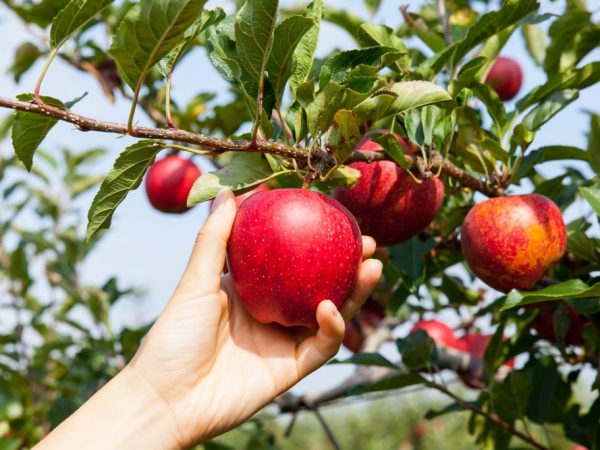
The fruits must be carefully removed from the tree.
The most convenient way to pick apples from dwarf trees. In many countries, for example, in Poland, just such varieties are grown for sale. They give no less yield, but they are more accessible for harvesting.
Can't be knocked off the branches. They are carefully removed, put in boxes and hidden.
Store apples in a cool, dry place. For small volumes, the bottom shelf of the refrigerator is suitable, and for boxes - a basement with good ventilation. They can lie without deterioration for about 6 months.
They retain their juiciness until the beginning of spring, although the pulp becomes looser at this time. The highest palatability is observed in late January and early February.
In which regions can be grown
The variety was bred for the southern regions. He has an average winter hardiness. Young seedlings and even mature trees can die at low temperatures. If in your area the temperature in winter often drops below 20 °, it is better to choose a different variety.
Theoretically, it is possible to grow in the Moscow region, if you cover the tree in severe frosts. But yields will be unstable. Indeed, in these regions there are often late frosts, which can destroy flowers and ovaries. So this variety can be planted in the middle lane only for home use.
Ideal places for growing are the southern regions of Russia (Kuban, Stavropol Territory, North Caucasus). It is quite possible to lay gardens here with the aim of selling the harvest in the future. The variety is drought tolerant, which makes it even more beneficial for cultivation in hot areas. Apple trees have taken root well in Ukraine, southern Poland and even southern Belarus. From these countries the variety is exported to Russia and Europe.
Reviews of gardeners
Many gardeners, when they first met the Idared variety, leave restrained reviews, because at first the taste of apples is weak. Only after 2-3 months of storage they become soft and juicy. Good transportability of the products is also noted. It can be transported hundreds of kilometers away without the slightest loss.
Previously, the fruit was given a tasting rating of "excellent". Now he is consistently getting "good". On a five-point scale, his data fell from 4.7 to 4. This is due to the fact that over the past decades there have been species that taste much better. As a result, prices fell.
As for leaving, according to gardeners' reviews, it is simple. It is important to monitor the trees so as not to miss the disease with powdery mildew and scab, pest attacks. To avoid problems, it is recommended to treat seedlings with copper sulfate, and adult trees - with fungicides, insecticides.
Idared is unpretentious to the soil, it can grow on loamy and clayey soils. To improve their properties, peat, humus, river sand are added to the planting pit.
Also, the tree does not need too much watering, which is also its positive feature when grown in the south.

